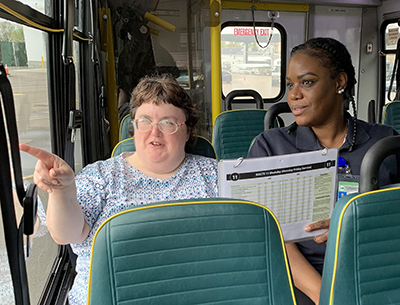Mobility Management
 Source: National Aging and Disability Transportation Center Photo Gallery
Source: National Aging and Disability Transportation Center Photo Gallery
Overview
Mobility management is an innovative approach for managing and delivering coordinated transportation services to customers, including older adults, people with disabilities, and individuals of low income. Mobility management focuses on meeting individual customer needs through a wide range of transportation options and service providers. It also focuses on coordinating these services and providers to achieve a more efficient transportation service delivery system.

Mobility managers serve as conveners, policy coordinators, operations service brokers, and customer travel navigators. As conveners, Mobility Managers bring together stakeholders with a shared interest in transportation to identify barriers and problem-solve solutions. As policy coordinators, mobility managers help communities develop coordination plans, programs, and policies, and build local partnerships. They also work to promote land-use policies that favor transit-oriented development, public transportation, and safe pedestrian access. As brokers, they coordinate public transit and human services transportation among all customer groups, service providers, and funding agencies. Finally, as travel navigators, they work with human services agencies and/or workforce centers that coordinate the travel and trip planning needs of individuals who receive human services program assistance.
Funding Mobility Management
Mobility management is an eligible capital expense under several U.S. Department of Transportation (USDOT) Federal Transit Administration (FTA) programs, including 49 U.S.C. § 5307, 5310, and 5311, and Fixing America’s Surface Transportation Act Section 3006(b). This means FTA can fund 80 percent of mobility management expenses. Federal Transit Law (49 U.S.C. § 5307(d)(1)(D); 49 U.S.C. § 5310(d)(3)(B); 49 U.S.C. § 5311(g)(3)(D) and (E)) also affords the option to use non-DOT federal transportation funding or service contracts to meet matching requirements. Federal Transit Law (49 U.S.C. § 5302) defines mobility management as a capital project, “consisting of short-range planning and management activities and projects for improving coordination among public transportation and other transportation service providers carried out by a recipient or subrecipient through an agreement entered into with a person, including a governmental entity, under [chapter 53] (other than section 5309); but excluding operating public transportation services.”

Mobility management activities eligible for funding include:
- Coordinating transportation services for older adults, individuals with disabilities, and individuals of low income, and ensuring their involvement in the process;
- Convening stakeholders and supporting multisector state and local partnerships to better coordinate transportation services;
- Participating in the development and implementation of coordination plans;
- Providing travel training and trip planning activities for customers;
- Developing and operating call centers to coordinate travel information, manage eligibility requirements, and arrange customer travel;
- Operating transportation brokerages to coordinate service providers, funding resources, and customer needs; and
- Planning and implementing the acquisition and purchase of intelligent transportation technologies to operate a coordinated system.
Resources
The following resources are publications and e-learning courses related to mobility management, produced by FTA, the Coordinating Council on Access and Mobility (CCAM), and/or FTA-funded technical assistance centers.
Relevant Publications
- 2023 – 2026 CCAM Strategic Plan
- CCAM Mobility Management Policy (coming soon)
- From the 2023 – 2026 CCAM Strategic Plan: The CCAM partner agencies will create an official CCAM mobility management policy statement. The official CCAM mobility management policy statement will ensure consistent mobility management eligibility across the eligible Federal programs (as of 2019, mobility management was eligible under 73 CCAM programs). From providing clarification to local transportation providers on what is permissible under funding rules, to answering questions from older adults regarding available transportation services, the mobility manager serves as a one-stop-shop regarding transportation and mobility options in the community they serve.
- U.S. Department of Labor, Bureau of Labor Statistics
- National Aging and Disability Transportation Center (NADTC)
- National Center for Applied Transit Technology (N-CATT)
- National Center for Mobility Management (NCMM)
- What is Mobility Management?
- Section 5310 Grant Funding: Connection with Mobility Management Information (April 2022)
- Promising Practices Catalog
- Technology for Mobility Management: A Framework for Moving Forward
- Building a Mobility Management Network: Characteristics and Considerations (April 2022)
- Effective Coordination Strategies: Mobility Ohio (March 2023)
- National Rural Transit Assistance Program (National RTAP)
- Shared-Use Mobility Center (SUMC)
- Transportation Technical Assistance Coordination Library (TACL)
Relevant Courses
- NADTC and National RTAP
- National RTAP eLearning; Search for “Cost Allocation Meets Coordination: A Mini-Course for Human Services Transportation Providers”
- National Transit Institute
- NCMM
- SUMC
